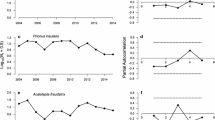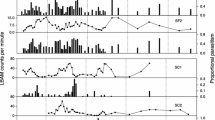Abstract
Scarcity of long-term (over 30 years) data series represents a major challenge for an accurate estimation of the role of density-dependent processes in population regulation. We analyzed population densities of the wingless parthenogenic morphs of buckthorn aphid (BA), Aphis nasturtii Kaltenbach, potato aphid (PA), Macrosiphum euphorbiae (Thomas), and green peach aphid (GPA), Myzus persicae (Sulzer) from 1949 to 2003 for signs of density-dependent regulation. We found strong evidence of density-dependent regulation, with detection of density dependence being fairly consistent among the different statistical techniques. Direct density dependence was detected for the populations of all three species. There was also evidence of delayed density dependence for PA. The periodicity of population fluctuations for BA and GPA was 6.1 years and 3.9 years, respectively. The periodicity for PA was not explicit, being highly variable throughout the time series. Effects of density-independent weather factors were relatively minor compared to density-dependent regulation. The BA populations experienced a significant reduction in both density and annual oscillations starting in 1995, while GPA populations experienced a similar reduction in 1991. No such change was apparent for PA. The most likely explanation for the observed phenomenon is a change in the composition of the lady beetle community following the establishment of two alien coccinellid species, and/or changes in insecticide use by commercial growers in the area of the study.







Similar content being viewed by others
References
Alyokhin A, Sewell G (2004) Changes in a lady beetle community following the establishment of three alien species. Biol Invasions 6:463–471
Baron WR, Smith DC, Borns HW Jr, Fastook J, Bridges AE (1980) Long-time series temperature and precipitation records for Maine, 1808–1978. Life Science Agriculture Experiment Station Bulletin 771, University of Maine, Orono
Berryman AA (1981) Population systems. Plenum, New York
Dixon AFG (1985) Aphid ecology. Blackie, Glasgow
Dixon AFG, Agarwala BK (1999) Ladybird-induced life-history changes in aphids. Proc R Soc Lond B 266:1549–1553
Emlen JM (1984) Population biology. Macmillan, New York
Ginsburg LRS, Ferson S, Akcakaya HR (1990) Reconstructibility of density dependence and the conservative assessment of extinction risks. Conserv Biol 4:63–70
Hanski I (1990) Density dependence, regulation, and variability in animal populations. Phil Trans R Soc Lond B 330:141–150
Hanski I, Woiwod I, Perry J (1993) Density dependence, population persistence, and largely futile arguments. Oecologia 95:595–598
Harvey AC, Pierse RG (1984) Estimating missing observations in economic time series. J Am Stat Assoc 79:125–131
Hassell MP, Latto J, May RM (1989) Seeing the wood for the trees: detecting density dependence from existing life table studies. J Anim Ecol 58:883–892
Holyoak M (1994) Identifying delayed density dependence in time series data. Oikos 70:296–304
Holyoak M, Lawton JH (1992) Detection of density dependence from annual censuses of bracken-feeding insects. Oecologia 91:425–430
Holyoak M, Lawton JH (1993) Comments arising from a paper by Wolda and Dennis: using and interpreting the results of tests for density dependence. Oecologia 95:592–594
Holyoak M (1993) New insights into testing for density dependence. Oecologia 93:435–444
Howard MT, Dixon AFG (1990) Forecasting of peak population density of the rose grain aphid Metopolophium dirhodum on wheat. Ann Appl Biol 117:9–19
Jarošík V, Dixon AFG (1999) Population dynamics of a tree-dwelling aphid: regulation and density-independent processes. J Anim Ecol 68:726–732
Kohn R, Ansley CF (1986) Estimation, predicition, and interpolation for ARMA models with missing data. J Am Stat Assoc 81:751–761
Maudsley MJ, MacKenzie A, Thacker JI, Dixon AFG (1996) Density dependence in cereal aphid populations. Ann Appl Biol 128:453–463
May RM, Hassell MP, Anderson RM, Tonkin DW (1981) Density dependence in host-parasitoid models. J Anim Ecol 50:855–865
Müller CB, Williams IS, Hardie J (2001) The role of nutrition, crowding and interspecific interactions in the development of winged aphids. Ecol Entomol 26:330–340
Morris RF (1963) Predictive population equations based upon key factors. Mem Entomol Soc Can 32:16–21
Pollard E, Lakhani KH, Rothery P (1987) The detection of density-dependence from a series of annual censuses. Ecology 68:2046–2055
Pianka ER (1974) Evolutionary ecology. Harper and Row, New York
Resampling Stats (1995) Resampling stats. Resampling Stats, Arlington
Radcliffe EB, Flanders KL, Ragsdale DW (1993) Management of aphids and leafhoppers. In: Rowe RC (ed) Potato health management. APS, St. Paul, pp 103–115
Royama T (1977) Population persistence and density dependence. Ecol Monogr 47:1–35
Royama T (1992) Analytical population dynamics. Chapman and Hall, London
SAS Institute (2002) JMP: the statistical discovery software, version 5. SAS Institute, Cary
Sequeira R, Dixon AFG (1997) Population dynamics of tree-dwelling aphids: the importance of seasonality and time scale. Ecology 78:2603–2610
Shands WA, Simpson GW, Lombard PM, Cobb RM, Lung PH (1950) Control of aphids on potatoes with DDT when used with fungicides. Maine Agriculture Experiment Station Bulletin 480, University of Maine, Orono
Shands WA, Simpson GW (1959) Characteristics of aphid-population growth on potatoes in northeastern Maine. Ann Entomol Soc Am 52:117–121
Shands WA, Simpson GW, Reed LB (1954) Subunits for estimating aphid abundance on potatoes. J Econ Entomol 47:1024–1027
Shands WA, Simpson GW, Hall IM (1963) Importance of entomogenous fungi in controlling aphids on potatoes in Northeastern Maine. Maine Agriculture Experiment Station Technical Series Bulletin T6, University of Maine, Orono
Shands WA, Simpson GW, Wave HE, Gordon CC (1972a) Importance of arthropod predators in controlling aphids on potatoes in Northeastern Maine. Life Science Agriculture Experiment Station Technical Bulletin 54, University of Maine, Orono
Shands WA, Simpson GW, Hall IM, Gordon CC (1972b) Further evaluation of entomogenous fungi as a biological control agent of aphid control in Northeastern Maine. Life Science Agriculture Experiment Station Technical Bulletin 58, University of Maine, Orono
Shands WA, Simpson GW, Gordon CC (1972c) Survey of internal parasites of potato-infesting aphids in Northeastern Maine, 1963 through 1969. Life Science Agriculture Experiment Station Technical Bulletin 60, University of Maine, Orono
Shands WA, Simpson GW, Seaman BA, Roberts FS, Flynn CM (1972d) Effects of differing abundance levels of aphids and of certain virus diseases upon yield and virus disease spread in potatoes. Life Science Agriculture Experiment Station Technical Bulletin 56, University of Maine, Orono
SPSS (2002) Missing value analysis. SPSS, Chicago
Stenseth NC, Framstad E (1980) Reproductive effort and optimal reproductive rates in small rodents. Oikos 34:23–34
Turchin P (1990) Rarity of density dependence or population regulation with lags? Nature 344:660–663
Turchin P, Taylor AD (1992) Complex dynamics in ecological time series. Ecology 73:289–305
Turchin P (1995) Population regulation: old arguments and a new synthesis. In: Cappuccino N, Price P (eds) Population dynamics: new approaches and synthesis. Academic, San Diego, pp 17–40
Turchin P (2003) Complex population dynamics: a theoretical/empirical synthesis. Princeton University, Princeton, N.J.
Wei WWS (1990) Time series analysis, univariate and multivariate methods. Addison–Wesley, Redwood City
Weisser WW, Braendle C, Minoretti N (1999) Predator induced morphological shift in the pea aphid. Proc R Soc Lond B 266:1175–1181
Wellings PW, Chambers RJ, Dixon AFG, Aikman DP (1985) Sycamore aphid numbers and population density. I. Some patterns. J Anim Ecol 54:411–424
Whittaker JB, Tribe NP (1998) Predicting numbers of an insect (Neophilaenus lineatus: Homoptera) in a changing climate. J Anim Ecol 67:987–991
Wilkinson L (1989) SYSTAT: the system for statistics. Systat, Evanston
Woiwod IP, Hanski I (1992) Patterns of density dependence in moths and aphids. J Anim Ecol 61:619–629
Wolda H, Dennis B (1993) Density dependence tests, are they? Oecologia 95:581–591
Wolda H, Dennis B, Taper ML (1994) Density dependence tests, and largely futile comments: answers to Holyoak and Lawton (1993) and Hanski, Woiwod and Perry (1993). Oecologia 98:229–234
Wool D (2002) Herbivore abundance is independent of weather? A 20-year study of a galling aphid Baizongia pistacia (Homoptera: Aphidoidea). Pop Ecol 44:281–291
Ylioja T, Roininen H, Ayres MP, Rousi M, Price PW (1999) Host-driven population dynamics in an herbivorous insect. Proc Natl Acad Sci USA 96:10735–10740
Acknowledgements
This work would not be possible without the detailed annual insecticide efficiency reports prepared and archived by W. Shands, G. Simpson, and R. Storch. We also thank R. Jardine for technical assistance during the last 40 field seasons, and C. Theriault for help with entering and summarizing the data. This is Publication No. 2821 of the Maine Agricultural and Forest Experiment Station.
Author information
Authors and Affiliations
Corresponding author
Rights and permissions
About this article
Cite this article
Alyokhin, A., Drummond, F.A. & Sewell, G. Density-dependent regulation in populations of potato-colonizing aphids. Popul Ecol 47, 257–266 (2005). https://doi.org/10.1007/s10144-005-0232-1
Received:
Accepted:
Published:
Issue Date:
DOI: https://doi.org/10.1007/s10144-005-0232-1




